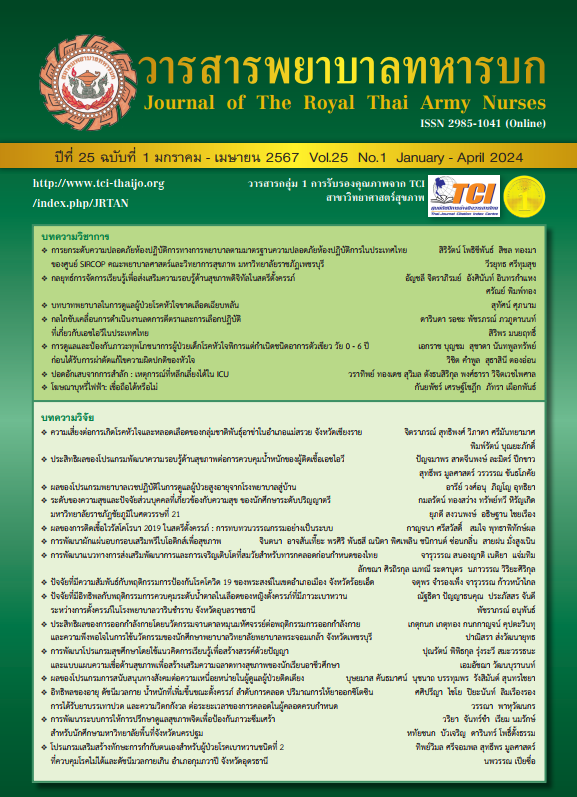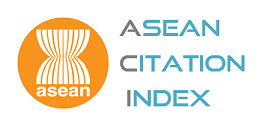การยกระดับความปลอดภัยห้องปฏิบัติการทางการพยาบาลตามมาตรฐาน ความปลอดภัยห้องปฏิบัติการในประเทศไทย ของศูนย์ SIRCOP คณะพยาบาลศาสตร์และวิทยาการสุขภาพ มหาวิทยาลัยราชภัฏเพชรบุรี
คำสำคัญ:
มาตรฐานความปลอดภัย, ห้องปฏิบัติการพยาบาล, ศูนย์ SIRCOPบทคัดย่อ
ความปลอดภัยเป็นสิ่งสำคัญสำหรับผู้ใช้บริการห้องปฏิบัติการพยาบาล ซึ่งผู้รับผิดชอบห้องปฏิบัติการยังไม่สามารถระบุ ประเด็นความปลอดภัยภายในห้องปฏิบัติการได้อย่างครอบคลุม ดังนั้นจึงนำมาตรฐานทางด้านความปลอดภัยห้องปฏิบัติการวิจัย ในประเทศไทยหรือ ESPReL มาเป็นแนวทางในการพัฒนา ป้องกันและการจัดการด้านความปลอดภัย ศูนย์ SIRCOP เป็นหน่วยงาน ที่รับผิดชอบห้องปฏิบัติการทางการพยาบาลเพื่อเป็นแหล่งการเรียนการสอน ศึกษาดูงานทั้งอาจารย์ นักศึกษาและบุคคลภายนอก ดังนั้นมาตรฐานความปลอดภัยถือเป็นหัวใจสำคัญในการดำเนินงานของศูนย์ SIRCOP โดยก่อนการยกระดับความปลอดภัยของห้อง ปฏิบัติการตาม ESPReL checklist พบสิ่งที่เป็นอันตรายหลายจุด ดังนั้นจึงได้มีการวางแผนจัดการประเด็นความเป็นอันตรายเพื่อ ยกระดับความปลอดภัยของห้องปฏิบัติการให้สูงขึ้น จากผลการดำเนินการห้องปฏิบัติการทั้ง 3 ห้องมีคะแนนที่เพิ่มมากขึ้นในทุก องค์ประกอบ โดยองค์ประกอบที่ 6 การให้ความรู้พื้นฐานเกี่ยวกับด้านความปลอดภัยในห้องปฏิบัติการ ได้คะแนนร้อยละ 100 ทั้ง 3 ห้อง องค์ประกอบรองลงมาคือ องค์ประกอบที่ 4 ลักษณะทางกายภาพของห้องปฏิบัติการ อุปกรณ์และเครื่องมือ ได้คะแนน ร้อยละ 97.6 ทั้ง 3 ห้อง ส่วนองค์ประกอบที่ได้คะแนนน้อยที่สุดคือ องค์ประกอบที่ 5 ระบบการป้องกันและแก้ไขภัยอันตราย ได้คะแนนระหว่างร้อยละ 69.2-70 โดยปัจจัยแห่งความสำเร็จที่สำคัญคือ การได้รับการสนับสนุนจากผู้บริหารทุกระดับ การสร้าง ความเข้าใจเกี่ยวกับมาตรฐานความปลอดภัยกับบุคคลที่เกี่ยวข้อง การมีโครงสร้างการทำงานที่ชัดเจน และการพัฒนาอย่างต่อเนื่อง
Downloads
เอกสารอ้างอิง
Kreunin P, Chaosrimud D, Borisuthi B. The development of laboratory safety management in metals and trace elements testing laboratory. Bulletin of Applied Science. 2013; 2(2): 55-61. (in Thai)
Wiriyakraikul C, Sorachoti K, Suppradid J. Establishing criteria for laboratory safety potential assessment in Thailand. Academic Journal of Architecture. 2019; 68: 35-54. (in Thai)
Thurapaeng W. The development of training activities using collaborative learning technique via social media for business for promote warehouse knowledge and participation behavior of employee in food industry business organization. Graduate School, Silpakorn University; 2021. (in Thai)
Jinakul N, Chanton D, Khammanit R. Hazard identification and risk assessment in biological laboratories. Burapha Journal of Medical. 2017; 4(2): 20-34. (in Thai)
Young JA. Safety in academic chemistry laboratories. Washington DC: American Chemical Society; 2003.
Nascimento EdS, Filho AT. Chemical waste risk reduction and environmental impact generated by laboratory activities in research and teaching institutions. Brazilian Journal of Pharmaceutical Sciences. 2010; 46(2): 187-98.
Omidvari M, Mansouri N, Nouri J. A pattern of fire risk assessment and emergency management in educational center laboratories. Safety Science. 2015; 73(3): 34-42.
Werajong O, Deepreecha K. Media for safety communication in occupational health nurses. Journal of The Royal Thai Army Nurses. 2022; 23(2): 10-15. (in Thai)
Wiriyakraikul C. Development of research laboratory safety models in Thailand. Academic Journal of Architecture. 2015; 64: 33-46. (in Thai)
ดาวน์โหลด
เผยแพร่แล้ว
รูปแบบการอ้างอิง
ฉบับ
ประเภทบทความ
สัญญาอนุญาต
ลิขสิทธิ์ (c) 2024 วารสารพยาบาลทหารบก

อนุญาตภายใต้เงื่อนไข Creative Commons Attribution-NonCommercial-NoDerivatives 4.0 International License.
บทความหรือข้อคิดเห็นใดใดที่ปรากฏในวารสารพยาบาลทหารบกเป็นวรรณกรรมของผู้เขียน ซึ่งบรรณาธิการหรือสมาคมพยาบาลทหารบก ไม่จำเป็นต้องเห็นด้วย
บทความที่ได้รับการตีพิมพ์เป็นลิขสิทธิ์ของวารสารพยาบาลทหารบก
The ideas and opinions expressed in the Journal of The Royal Thai Army Nurses are those of the authors and not necessarily those
of the editor or Royal Thai Army Nurses Association.







